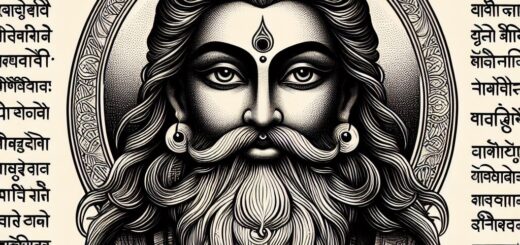The Temple and the Body(Vachana)
Kannada version
The rich
will make temples for Siva.
What shall I,
a poor man,
do?
ಉಳ್ಳವರು
ಶಿವಾಲಯ ಮಾಡಿಹರು,
ನಾನೇನ ಮಾಡುವೆ
ಬಡವನಯ್ಯಾ.
My legs are pillars,
the body the shrine,
the head a cupola
of gold.
ಎನ್ನ ಕಾಲೇ ಕಂಬ,
ದೇಹವೇ ದೇಗುಲ,
ಶಿರ ಹೊನ್ನ ಕಲಶವಯ್ಯಾ.
Listen, O lord of the meeting rivers,
things standing shall fall,
but the moving ever shall stay.
ಕೂಡಲಸಂಗಮದೇವಾ
ಕೇಳಯ್ಯಾ ಸ್ಥಾವರಕ್ಕಳಿವುಂಟು
ಜಂಗಮಕ್ಕಳಿವಿಲ್ಲ.
Notes
II. COMPREHENSION QUESTIONS :
A. Answer briefly the following questions :
- The lines “The rich / will make temples for Siva,” implies that
a. they want to please the lord
b. they can afford to build temples
c. they believe that this is how they can serve God
d. they believe that the temple is the only place to feel the presence of God.
Ans:(c) they believe that this is how they can serve God.
- Which of the following statements are true?
a. The speaker is against building any structures for worshipping God
b. It’s not possible for the speaker to build a temple.
c. It’s only an excuse given by the speaker for not being able to
build a temple.
d. The speaker believes that God is present within ourselves and
not in any temple.
Ans:(d) the speaker believes that God is present within ourselves and not in any temple.
- What are the feelings of the speaker, suggested in the question,
“What shall I, a poor man, do?”
a. helplessness b. doubt
c. humility d. anger
e. pride. f. anguish.
Ans:(f) anguish
- The word “Listen” in the last stanza is
a. an order b. an appeal
c. a request d. an advice
Ans:(d) an advice
- The expression “Things Standing,” suggests
a. any man-made temple b. anybody who is standing
c. anything which is static d. the human body.
Ans:(c) anything which is static
- There are two examples of paradox in the last two lines. (A paradox
is a statement containing opposite ideas.)
i) What opposite ideas are suggested in “things standing shall
fall?”
Ans:Things standing shall fall’ can be interpreted in various ways. The poet laments his inability to build temples, hence the phrase can refer to temples which are subject to nature’s fury and destruction over a period of time. It can also refer to pride and arrogance which can make a person stand erect in front of God when he should be bowing before Him. It may also mean that static objects that are moved by piety and devotion, are subject to destruction and decay while the heart that is filled with devotion is blessed and becomes immortal.
ii) What opposite ideas are suggested in “the moving shall eve
stay?”
Ans:The moving shall ever stay’ – this phrase too can be interpreted in many ways. The ‘moving’, i.e., the human heart which is a ‘moving temple’ cannot be destroyed by nature’s fury unlike a temple that can be damaged easily by nature, ‘the moving’ can also refer to humble beings who are swayed by devotion and move according to God’s will unlike the ‘static’ that stand erect against God’s wishes and get destroyed.
These two phrases repeat the message of the line from the Bible:
“Be not like the mighty oak which can be filled, with a single stroke; Be like the humble reed which bends with the wind and stays.
7.What final message do the last two lines convey?
Ans:The poet is consoling himself that the temple which he would never be able to construct, would any day be destroyed, whereas the ‘moving temple’ that he carries in his heart would be immortal and intact. The lines can also mean that the one who ‘stands’ in front of God without bowing down to Him, will surely ‘fall’ or be destroyed, whereas ‘the moving’, the one who bows down in front of Him and acts according to His wish, would stay ever. The poet finds consolation in his modest circumstances and his devotion to God.
B. Close Study
Read the following extract carefully. Discuss in pairs and then write
the answers to the questions given below it.
My legs are pillars,
the body the shrine,
the head a cupola of gold.
- How is the human body compared to a temple?
Ans:The whole body is compared to a temple, with the legs being pillars, the body the shrine with the idol of God secure in the heart, and the head, a cupola of gold with serene thoughts protecting the God in the heart.
2.What is the figure of speech used here?
Ans:The figure of speech used here is a metaphor.
3.Why is the speaker comparing the human body to a temple?
Ans:The speaker wanted to construct a temple like the rich people do, and thereby please God, but he is very poor and cannot do so. Hence he decides to treat his own body as a temple with the God secure in his heart. – He also realizes that the temple built of brick and stone can be damaged by nature one day, whereas the ‘moving temple’ in his heart can never be.
III. PARAGRAPH WRITING :
Discuss in pairs / groups of four each and answer the following question. Note down the important points and then develop the points into a paragraph.
1.What ideas of spirituality emerge from the study of this well known Vachana?
Ans:
- Building temples for Siva is considered a good way to please the Lord.
- However, everyone cannot build temples.
- Temples built of stone and brick can be destroyed.
- God is found not just in temples but also outside.
- Carrying God in one’s own heart is the best way of worshipping Him.
- This ‘moving temple’ cannot be destroyed at all.
Paragraph: In this poem, Basavanna tells us that a rich man can afford to build grand temples in honour of gods, but poor man can’t. However, with his devotion, i.e., with pure thoughts, actions and deeds, he can turn his body into a temple. He may offer his legs for pillars, his body fora shrine and his head for a cupola. A temple of faith is immortal as human beings live on generation after generation, but a temple of stone will perish sooner or later. With this analogy, the lyricist is telling us that faith in the heart is more important than cold stone structures dedicated to a God. To him true faith is more important than display of wealth by the rich who put up such structures.




























